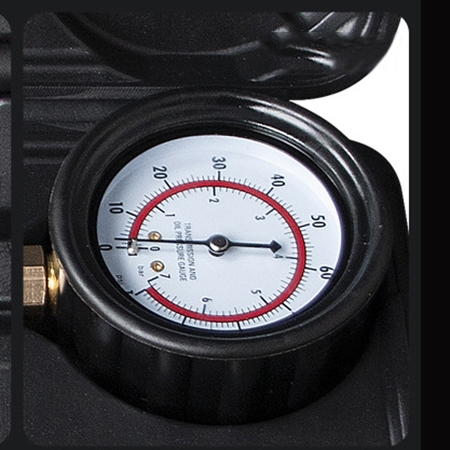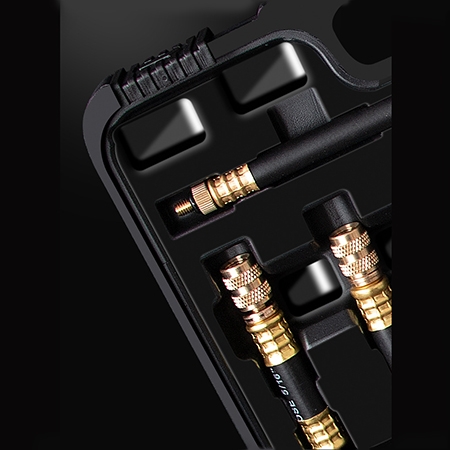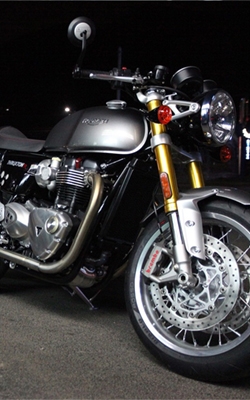SISCO fuel pressure gauge kit includes a durable, high-quality gauge, along with all necessary hoses, fittings, and adapters, allowing for quick and easy connection to most vehicles, including cars, trucks, and other fuel-injected machinery. The pressure gauge is easy to read, and the connections are designed for a secure, leak-proof fit. This fuel injection pressure gauge set is an ideal tool for both professionals and DIY enthusiasts looking to check fuel pressure with minimal hassle.

Sophisticated Dial Design
- Fine and Detailed Scale: The fuel pressure gauge is designed with a finely graduated dial, allowing users to read even subtle changes in fuel pressure with ease and confidence.
- Accurate Pressure Display: This fuel preesure tester provides a precise indication of the fuel pressure values, ensuring that measurements are both reliable and easy to interpret during vehicle diagnostics.
- Low-Range Precision: With a minimum scale that extends to very low pressure levels, the gauge can capture slight variations that are critical for troubleshooting fuel system issues.
- Essential Diagnostic Tool: By clearly showing the fuel system’s pressure status, it helps mechanics and technicians accurately assess the condition of the fuel pump, regulator, and injectors, leading to more efficient maintenance and repairs.

All-copper Joint, High Hardness and Good Toughness
- Solid Brass Fittings: The fuel pressure gauge's joint is made from high-quality copper for exceptional corrosion resistance and long-term durability.
- High Hardness: The brass fittings are designed with high hardness, providing strength and the ability to withstand high-pressure environments.
- Good Toughness: The fittings offer excellent toughness, ensuring they can handle repeated use without cracking or breaking, even under stress.
- Enhanced Durability: The combination of high hardness and toughness ensures the tester kit withstands the rigors of regular, heavy-duty use.
Application
SISCO fuel pressure gauges are used to monitor and diagnose the fuel system in vehicles and machinery, ensuring the fuel pump and regulator deliver the correct pressure. It is commonly applied in cars, motorcycles, sports car, trucks, off-road vehicles, and agricultural equipment to maintain engine performance, improve efficiency, and quickly identify fuel system problems.

Sports Car

Agricultural Vehicle

Motorcycle

Off-road Vehicle
| Model | SISCO-FPG-4188 |
| Measuring Range | 0-100 psi |
| Accuracy | 0.1 |
| Connection Type |
Direct connection |
| Dial Size |
65mm |
| Ambient Temperature | 0-45°C |
| Interface Materials | Brass |
| Size | 310*230*60mm |
| Weight | 2kg |
Q1: What is a fuel pressure gauge?
A1: A fuel pressure gauge is a diagnostic and monitoring instrument designed to measure the pressure within a vehicle’s fuel system, ensuring that the fuel pump and regulator are supplying the engine with the correct amount of fuel for efficient operation. By providing accurate pressure readings, it helps mechanics and vehicle owners quickly identify issues such as weak fuel pumps, clogged filters, leaking lines, or malfunctioning regulators that could cause hard starting, poor performance, or even engine damage. Fuel pressure gauges come in both mechanical and electronic types, with mechanical gauges typically used for quick under-hood checks and electronic gauges often paired with sending units for real-time, in-cabin monitoring. They are widely used across different applications, from carbureted engines that require low-pressure readings to modern EFI systems and high-performance or diesel engines that demand higher pressure ranges, making them an essential tool for both troubleshooting and ongoing performance management.
Q2: Why do I need a fuel pressure gauge?
A2: You need a fuel pressure gauge because it plays a crucial role in ensuring that your vehicle's fuel system is operating at the correct pressure, which is vital for proper engine performance, fuel efficiency, and long-term reliability. Without the right fuel pressure, your engine may experience hard starting, rough idling, hesitation during acceleration, misfires, excessive fuel consumption, or even stalling, all of which can lead to costly repairs if not addressed promptly. A fuel pressure gauge allows you to quickly and accurately diagnose whether problems are caused by a weak or failing fuel pump, a clogged fuel filter, a leaking fuel line, or a faulty pressure regulator, saving time during troubleshooting and helping prevent unnecessary part replacements. For performance enthusiasts and diesel or high-horsepower applications, a fuel pressure gauge is also an important monitoring tool, giving you real-time feedback to ensure the engine is always supplied with adequate fuel under varying loads and driving conditions.
Q3: Where do I put fuel pressure gauge?
A3: A fuel pressure gauge can be installed in different locations depending on whether it is used for temporary testing or permanent monitoring. For diagnostic purposes, it is commonly connected to the Schrader valve on the fuel rail, spliced inline with the fuel line, or attached to the test port on the fuel pressure regulator. For long-term use, the gauge may be mounted under the hood for quick visual checks, or paired with an electronic sending unit that transmits readings to a gauge inside the cabin, allowing the driver to monitor fuel pressure in real time. This electronic setup is preferred for safety, since it avoids the hazard of running a raw fuel line into the passenger compartment.
Tips: How do I calibrate a mechanical fuel pressure gauge?
Mechanical gauges typically do not need calibration, as they are direct-read instruments. However, if you suspect an issue, you can:
- First, ensure the gauge is installed correctly with no leaks and is positioned for easy reading.
- Then, gradually apply pressure and compare the readings from the mechanical gauge with the reference source at multiple pressure levels. If discrepancies are found, adjust the internal components of the gauge, such as the Bourdon tube, to correct the readings.
- Additionally, check that the needle rests at zero when no pressure is applied. After making adjustments, test the gauge under normal conditions to confirm its accuracy. If it still shows errors, the gauge may need to be replaced.
Thank you for buying industrial test and measurement equipment on SISCO.com, all products sold by SISCO and the partner cover a 12 months warranty, effective from the date of receiving the products.
What is covered?
SISCO is responsible for providing free spare parts, and free technical support to assist the customer to repair the defective products until the problem is solved.
What is not covered?
- Product purchased from anyone other than a SISCO store or a SISCO authorized reseller.
- Expendable parts.
- Routine cleaning or normal cosmetic and mechanical wear.
- Damage from misuse, abuse or neglect.
- Damage from use of parts other than SISCO approved.
- Damage from use outside the product’s usage or storage parameters.
- Damage from use of parts not sold by SISCO.
- Damage from modification or incorporation into other products.
- Damage from repair or replacement of warranted parts by a service provider other than a SISCO authorized service provider.
- Damage caused by the application environment not meeting the product usage requirements and the failure to perform preventive maintenance.

